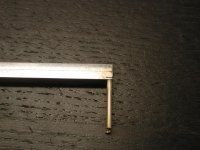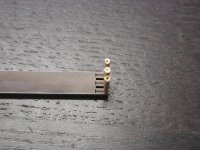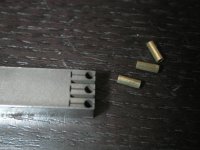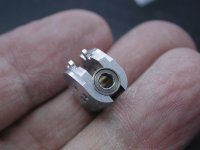implmex
Diamond
- Joined
- Jun 23, 2002
- Location
- Vancouver BC Canada
Hi All:
Recently there was a thread on here that I can't find anymore about cutting hypodermic tubing to length.
Well it just so happens I have 5.5 mm long standoffs to cut from brass tubing 2 MM OD and 1.25 MM ID that need to be accurate within a couple of tenths.
I remembered that thread and thought I'd post a couple of pix about how I do it on the wire EDM so if someone else confronts this kind of problem they can see a potential solution they could choose if they want to.
So here they are.
The jig is a chunk of Ti6Al4V titanium, chosen because it's springy.
I cut the pattern you see into it and then pushed in the rough cut tube stock.
The tubing bores in the jig are 0.0003" undersize and the Tee shaped relief slots make it easy to push the tubes in but still hold them very well.
The jig was flipped 90 degrees in the vise and the one tube end was faced with the wire, then a slot was cut and skimmed at the other end, bringing the tubes to length within a tenth.
It cuts three at a time and I have twelve to cut.
The jig took a couple of hours to program and cut; 3 standoffs take about 5 minutes to rough and skim, so a total of 2 1/2 hours for the job .
Attached also is a couple of pictures of the assembly with the standoffs and the bearings in place.
Cheers
Marcus
Implant Mechanix • Design & Innovation > HOME
Vancouver Wire EDM -- Wire EDM Machining
Recently there was a thread on here that I can't find anymore about cutting hypodermic tubing to length.
Well it just so happens I have 5.5 mm long standoffs to cut from brass tubing 2 MM OD and 1.25 MM ID that need to be accurate within a couple of tenths.
I remembered that thread and thought I'd post a couple of pix about how I do it on the wire EDM so if someone else confronts this kind of problem they can see a potential solution they could choose if they want to.
So here they are.
The jig is a chunk of Ti6Al4V titanium, chosen because it's springy.
I cut the pattern you see into it and then pushed in the rough cut tube stock.
The tubing bores in the jig are 0.0003" undersize and the Tee shaped relief slots make it easy to push the tubes in but still hold them very well.
The jig was flipped 90 degrees in the vise and the one tube end was faced with the wire, then a slot was cut and skimmed at the other end, bringing the tubes to length within a tenth.
It cuts three at a time and I have twelve to cut.
The jig took a couple of hours to program and cut; 3 standoffs take about 5 minutes to rough and skim, so a total of 2 1/2 hours for the job .
Attached also is a couple of pictures of the assembly with the standoffs and the bearings in place.
Cheers
Marcus
Implant Mechanix • Design & Innovation > HOME
Vancouver Wire EDM -- Wire EDM Machining







